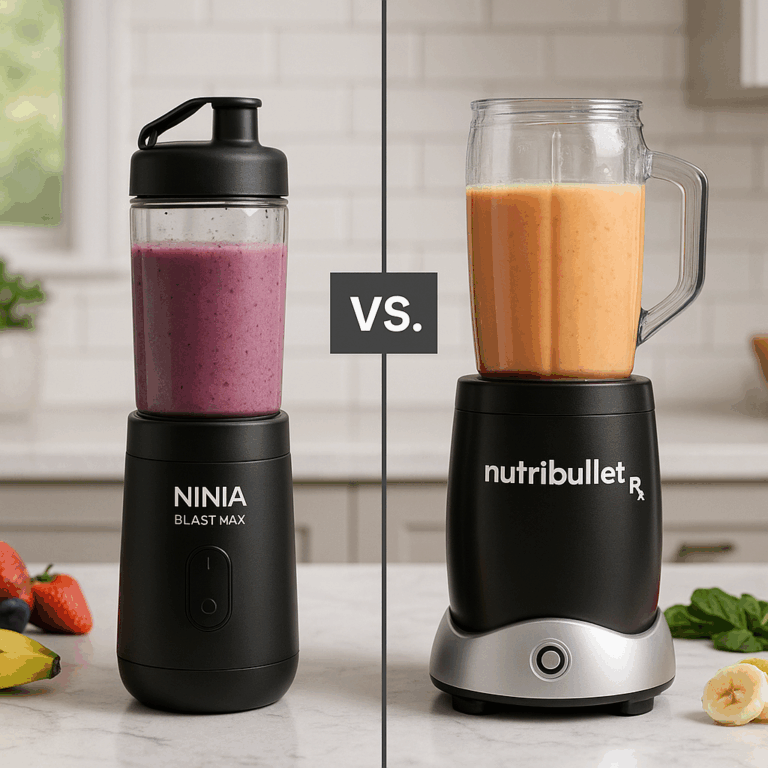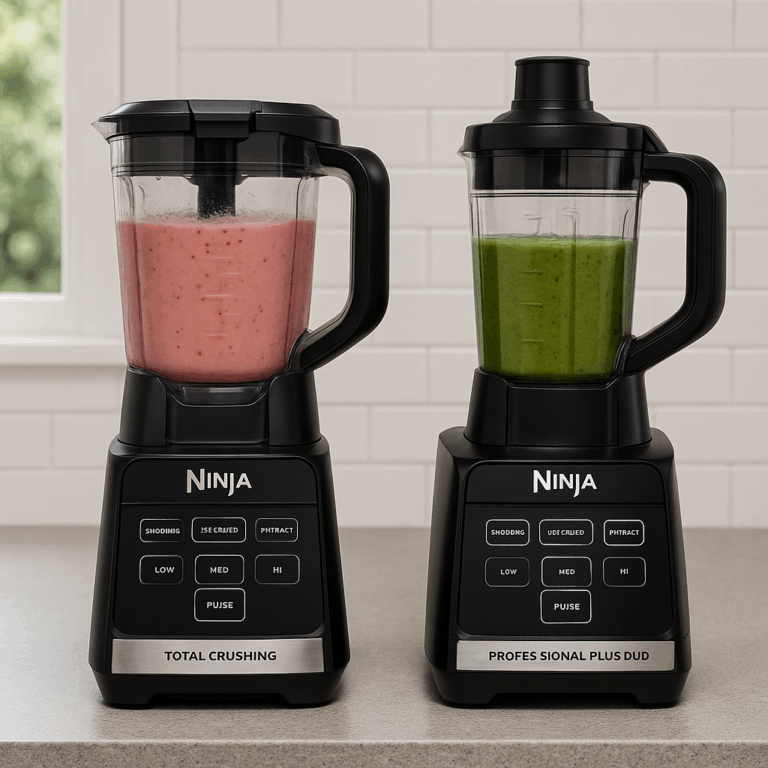If you’re in the market for a smart, high-performance blender, chances are you’re looking at the Vitamix A2500 and A3300. Both are part of Vitamix’s Ascent Series, known for their power, smart features, and sleek designs. But despite their similarities, they serve different user types. In this guide, we compare the A2500 vs A3300 in depth, based on specs, usability, smart features, cleaning, pricing, noise, control interfaces, and more. Having tested and researched both blenders, we’re here to help you confidently choose the model that best fits your kitchen routine in 2025.
Table of Contents
Key Differences Between the Vitamix A2500 and A3300
While both models share the same core motor and smart blending foundation, a few distinct differences set them apart:
- Controls: The A2500 uses traditional dial and toggle switches, while the A3300 features a sleek touchscreen interface.
- Preset Programs: The A2500 includes 3 automatic blending programs (Smoothies, Hot Soups, Frozen Desserts). The A3300 has no presets, relying on manual control.
- Digital Timer: The A3300 includes a built-in programmable timer; the A2500 does not.
- Design: The A3300 looks more modern with its flush touchscreen, appealing to minimalist kitchens.
- Price: The A3300 typically costs $50–$100 more, depending onthe retailer and sales.
Both models include Vitamix’s Smart Detect container system, pulse feature, and 10-year full warranty.
Performance: Are They Equal Under the Hood?
Underneath their control panels, the A2500 and A3300 are almost identical:
- Motor Power: Both pack a 2.2-peak horsepower motor—plenty for smoothies, soups, nut butters, doughs, and more.
- Blade System: Stainless steel laser-cut blades that blend hard ingredients like ice or seeds with ease.
- Smart Detect: Both use Self-Detect containers that adjust settings and prevent blending without the lid secured.
- App Compatibility: You can pair either blender with the Vitamix Perfect Blend App for access to 17+ programs.
So in terms of raw power and blending capability, they perform identically.
Interface: Dial vs Touchscreen
This is where the biggest usability difference lies.
A2500 Interface:
- Traditional analog dial (10-speed control)
- Pulse switch
- Start/stop switch
- 3 presets: Smoothies, Hot Soup, Frozen Dessert
A3300 Interface:
- Digital touchscreen panel
- Capacitive slider for manual speed control
- Pulse button (touch)
- Start/stop touch control
- Built-in digital countdown timer (you set blend time manually)
Pros of A2500’s interface: Easier for beginners, tactile feedback, more “classic blender” feel.
Pros of A3300’s interface: Sleeker design, quieter interface, great for tech-savvy users who prefer digital control.
Built-in Timer: Useful or Gimmick?
The A3300 includes a programmable digital timer. You set the desired blend time, and the blender shuts off automatically when finished. This is useful if:
- You want repeatable consistency (same smoothie daily)
- You’re multitasking and want the blender to stop on its own
However, many users find that the 3 preset programs on the A2500 serve a similar purpose, making the built-in timer less essential for casual users.
Noise, Design, and Aesthetics
- Noise Level: Both are loud, but the A3300 is slightly quieter due to its tighter interface design with fewer gaps.
- Look & Feel: A2500 looks more traditional. A3300 has a more modern aesthetic—no physical knobs or switches.
- Size & Weight: Nearly identical in footprint and weight (~11 lbs), so no real difference in counter space.
Cleaning and Maintenance
Both blenders are easy to clean:
- Self-cleaning function: Add warm water + dish soap, run on high speed.
- Smart sensors: Keep the lid and base clean to avoid detection errors.
- Touchscreen (A3300): Wipe with a damp microfiber cloth only—no direct water or sprays.
For deep cleaning and specific care, see our Vitamix A2500 Cleaning Guide.
Smart Features and App Integration
Both blenders work with the Vitamix Perfect Blend App, unlocking 17+ blending programs and hundreds of guided recipes.
- App Setup: Bluetooth sync with Android or iOS
- Features Available in App:
- Custom recipe tracking
- Nutrition info
- Remote blend controls
This means that even if your blender lacks physical presets (like the A3300), the app makes up for it with robust automation and control.
Accessories & Upgrade Paths
Both the Vitamix A2500 and A3300 are part of the Ascent Series, making them compatible with a wide range of optional accessories. Whether you’re looking to expand your blending tasks or want more flexibility in the kitchen, here’s what you can pair with each model:
✅ Compatible Accessories:
- 8-ounce blending cups (great for personal smoothies or dressings)
- 20-ounce blending cups with lids (ideal for travel-friendly smoothies)
- Dry grains container (for grinding coffee, flour, or spices)
- Food processor attachment (turn your blender base into a multi-use prep station)
Because both blenders use Smart Detect technology, they automatically recognize which container you’re using and adjust settings accordingly. This ensures consistent results no matter which accessory you attach.
If you want a blender that grows with your needs, either model offers excellent upgrade potential, but users who love touchscreen precision might appreciate pairing the A3300 with the food processor attachment for advanced prep work.
Price and Value: Which Is More Worth It in 2025?
| Model | Typical Price | Best For |
|---|---|---|
| A2500 | $449–$499 | Budget-conscious buyers who want presets |
| A3300 | $499–$599 | Design-forward users who like digital control |
If you care more about tactile presets and saving money, the A2500 wins. If you like a sleek, modern blender with digital control, the A3300 may be worth the upgrade.
Real-World Use Case Examples
To help you decide, here’s how each blender fits into daily routines:
✔ Vitamix A2500 Scenario:
Imagine you’re a busy parent who loves preset simplicity. You toss in frozen bananas, spinach, and almond milk, turn the dial to the Smoothie preset, hit start, and walk away. Later, you use the Hot Soup preset for quick weeknight meals, all without worrying about manual settings.
✔ Vitamix A3300 Scenario:
Picture a home chef who values precision. You want to make a silky salad dressing, so you set the programmable timer for 45 seconds on medium speed. While it blends, you prep the salad, knowing the blender will stop automatically. Or maybe you’re making a layered dessert puree and love the touchscreen’s exact control over blend time and speed.
Who Should Buy the Vitamix A2500?
Choose the Vitamix A2500 if you:
- Prefer physical dials and toggles over touch controls
- Want 3 built-in preset programs (Smoothies, Soup, Frozen Desserts)
- Like simplicity and intuitive use
- Are sticking to a tighter budget
Read the full review here: Vitamix A2500 Review
Who Should Buy the Vitamix A3300?
Choose the Vitamix A3300 if you:
- Want a sleeker, more modern touchscreen design
- Like setting your own blend times with the digital timer
- Don’t need preset programs and are comfortable with manual control
- Don’t mind paying a bit more for style and interface
For a deeper dive into this model, read our full Vitamix A3300 review.
Pros and Cons Summary
Vitamix A2500 Pros:
✅ Physical controls are easy and intuitive
✅ Three built-in presets (Smoothies, Hot Soup, Frozen Desserts)
✅ Lower price point compared to A3300
✅ Classic Vitamix design with tactile feedback
Vitamix A2500 Cons:
⚠ No programmable timer
⚠ Analog design may feel dated to some users
Vitamix A3300 Pros:
✅ Sleek touchscreen interface
✅ Programmable digital timer for precise blends
✅ Sleek, minimalist look fits modern kitchens
✅ Quieter operation thanks to tighter design
Vitamix A3300 Cons:
⚠ No preset programs (requires manual control or app use)
⚠ Slightly higher price
Final Verdict: Which One Is Right for You?
The A2500 and A3300 are both powerful, durable, and packed with smart features. Your decision comes down to interface preference and how you like to blend.
- Choose the Vitamix A2500 if you want built-in programs and classic controls.
- Choose the Vitamix A3300 if you prefer a modern touchscreen, programmable timer, and don’t need presets.
Both models deliver the full Vitamix experience—blending power, reliability, and 10-year warranties.
Want to compare more blenders, explore top picks, or dive into cleaning and recipe guides?
Visit our complete Blender Reviews and Buying Guides here.
FAQ: Vitamix A2500 vs A3300
Do both models support Self-Detect containers?
Yes, both recognize compatible Vitamix containers automatically.
Can I use the Vitamix app with either blender?
Yes, both pair with the Perfect Blend App via Bluetooth.
Is the A3300 quieter than the A2500?
Slightly, due to the sealed touchscreen and tighter design.
Which blender is easier to clean?
Both are equally easy. The A3300 requires more delicate wiping on the touchscreen.
Do they come with the same accessories?
Yes, typically a 64oz container, tamper, and user guide. Accessories may vary slightly by seller.
Is the digital timer on the A3300 worth it?
If you want hands-free consistency and more control, yes. Otherwise, the A2500’s presets serve similar purposes.
Are both covered by warranty?
Yes, both have a 10-year full Vitamix warranty.
Can I make hot soups and nut butters in both models?
Absolutely. Both are capable of blending hot ingredients and dense items like nut butters, due to their powerful 2.2 HP motors.
Want to explore more smart blender matchups or see how other models compare side-by-side? Be sure to explore our expert blender matchups for in-depth breakdowns.


